To build a home Plex server on ARM hardware, start by choosing a suitable device like a Raspberry Pi 4 or Odroid N2+ that can handle transcoding. Install a lightweight Linux OS such as Ubuntu Server, then download and set up Plex Media Server. Configure your network with static IPs and port forwarding, and organize your media files efficiently. Optimizing performance and securing your setup are key—continue along to discover detailed steps to make your server reliable and easy to use.
Key Takeaways
- Select a suitable ARM device like Raspberry Pi 4 or Odroid N2+ with sufficient CPU, RAM, and hardware transcoding support.
- Install a lightweight Linux OS such as Ubuntu Server or Debian and update all system packages.
- Configure static IP, set up port forwarding, and organize media storage for reliable remote access and management.
- Download and install the correct Plex Media Server version compatible with your ARM architecture.
- Enable hardware acceleration, secure remote access with strong passwords or VPN, and perform regular updates for optimal performance.
Choosing the Right ARM Device for Your Plex Server
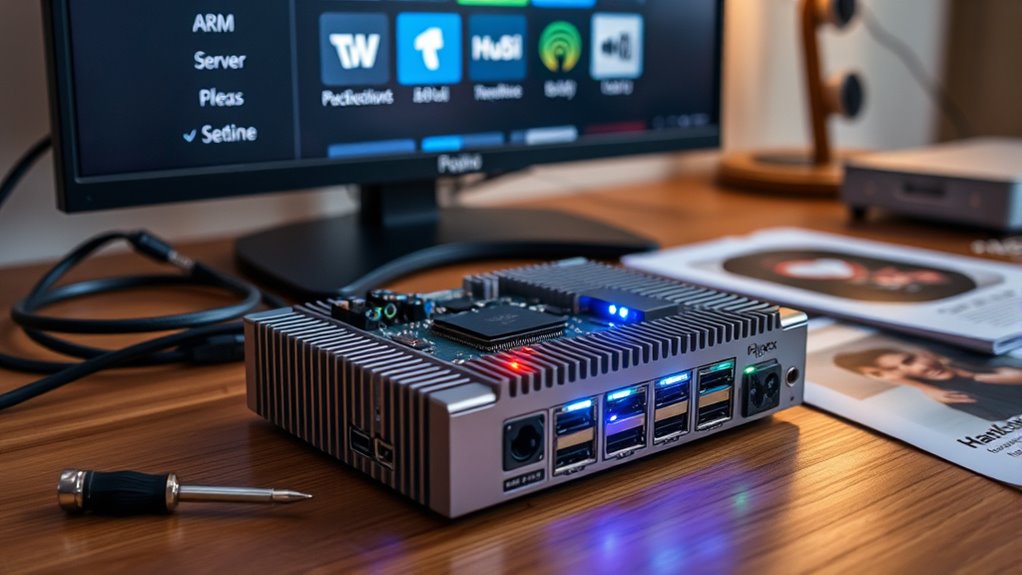
When selecting an ARM device for your Plex server, it’s important to take into account your streaming needs and budget. Consider how many simultaneous streams you’ll support and whether you’ll handle high-resolution content like 4K videos. If you plan to stream multiple devices at once or work with large media files, opt for a device with a powerful processor and ample RAM. Budget-friendly options like Raspberry Pi 4 are suitable for light usage, but for better performance, you might choose a more robust ARM SBC like the Odroid N2+ or a dedicated ARM-based mini PC. Keep in mind that compatibility and community support vary across devices, so research your options thoroughly to assure smooth playback and manageable setup. Your choice should align with your media demands and financial constraints. Additionally, paying attention to the security vulnerabilities associated with your chosen hardware can help protect your media library from potential threats.
Preparing Your Hardware and Operating System
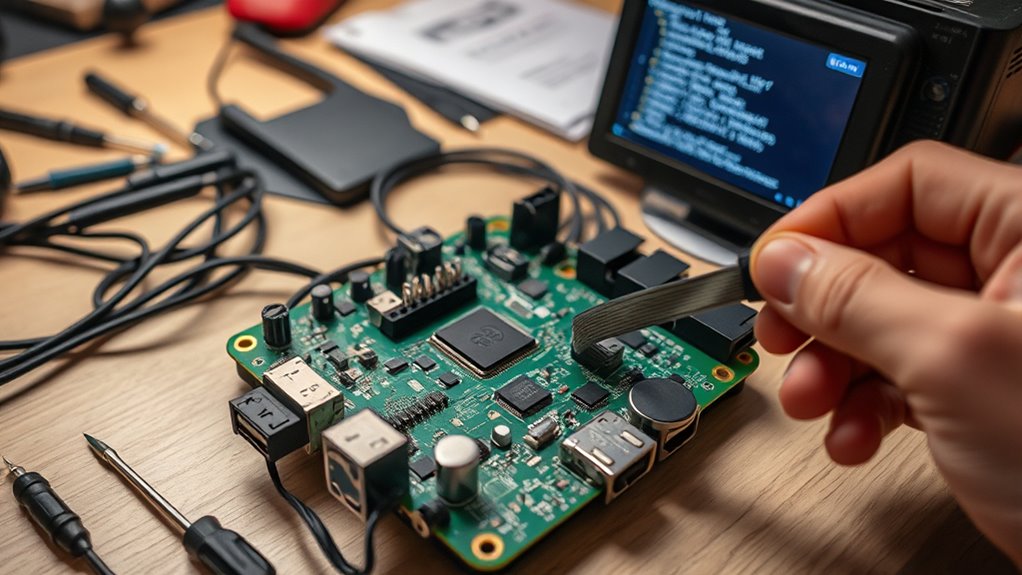
Before setting up your Plex server, you need to prepare your hardware and operating system. This involves choosing a compatible ARM device, installing an appropriate OS, and configuring your network settings. Getting these steps correct ensures a smooth and reliable streaming experience. Additionally, understanding the hardware specifications of your device helps optimize performance and compatibility.
Selecting Compatible ARM Devices
Choosing the right ARM device is essential for building a reliable Plex server, as not all hardware offers the same level of compatibility and performance. You need a device that can handle media transcoding, streaming, and network demands without lag or crashes. Consider factors like processing power, RAM, and connectivity options to guarantee smooth operation. Some ARM devices are better suited for media servers due to their hardware features. Additionally, verifying the device’s support for Gold IRA Rollovers and related security features can ensure your media server remains protected against potential threats.
- Check if the device supports hardware transcoding for better media handling
- Ensure it has enough RAM for multiple streams
- Confirm network interfaces support gigabit Ethernet for fast data transfer
- Look for community support and firmware updates
- Verify compatibility with your preferred operating system
Installing a Suitable OS
Selecting the right operating system is essential to guarantee your ARM device runs your Plex server smoothly and reliably. You should choose an OS optimized for your hardware, such as Ubuntu Server, Debian, or a lightweight Linux distribution like Arch Linux ARM. These options offer stability, good community support, and compatibility with Plex. Download the latest stable version suited for ARM architecture from official sources. Before installing, confirm your SD card or SSD has enough space and is formatted correctly. Follow the installation instructions specific to your chosen OS, paying attention to any device-specific steps. Once installed, update the system packages to ensure security and stability. A well-prepared OS forms the foundation for a seamless, long-term Plex server experience on your ARM hardware. Additionally, understanding the angel numbers and their meanings can provide spiritual guidance and encouragement during your setup process.
Configuring Network Settings
Once your operating system is installed and updated, the next step is to configure your network settings to ensure reliable access and streaming. Proper setup helps prevent buffering issues and keeps your server accessible on your local network. Start by assigning a static IP address to your device to avoid IP changes. Enable port forwarding on your router to allow external access if needed. Consider setting a DHCP reservation to keep the IP consistent. Check your firewall rules to permit Plex traffic. Finally, test the connection to confirm your server is reachable from other devices. Understanding network configuration is essential for maintaining a stable server environment.

Before you can set up your home Plex server on ARM hardware, you need to install the essential dependencies and tools. Start by updating your system’s package list with `sudo apt update` to make sure you have the latest information. Install necessary packages like `curl`, `wget`, and `git` for downloading and managing files. You’ll also need `apt-transport-https` to handle secure repositories. If you plan to compile software or run certain scripts, install build tools like `build-essential`. For managing services, ensure `systemd` is active. Installing these dependencies guarantees your system is ready for Plex and related components. Once these are set, you can confidently move on to downloading and configuring Plex Media Server without interruptions.
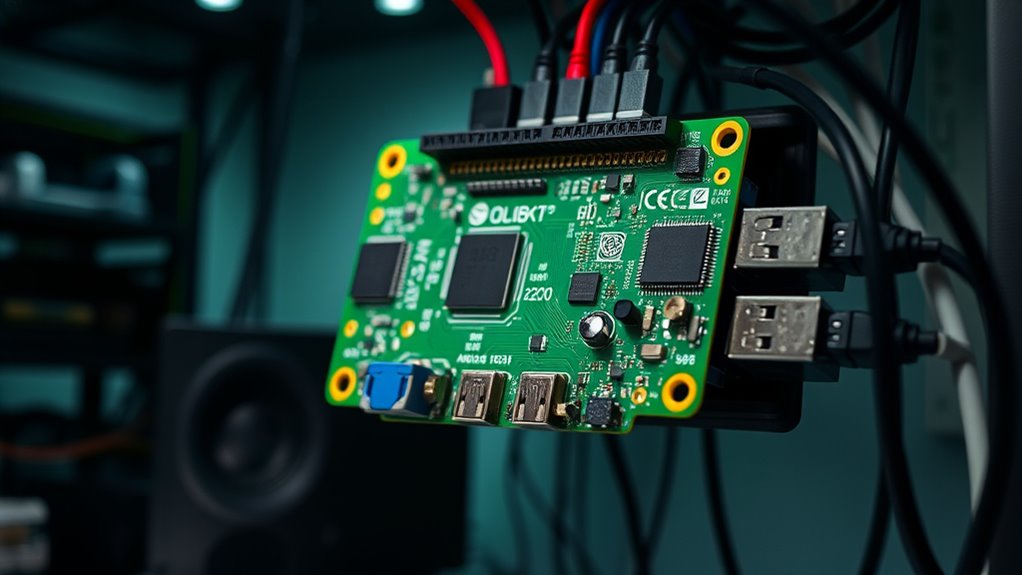
Now that your dependencies are in place, it’s time to download the Plex Media Server. You’ll need to install the software and set up your storage options to organize your media library effectively. Let’s walk through each step to guarantee your server runs smoothly. To optimize your setup, consider media library organization strategies that enhance accessibility and management.
Installing Plex Server
Are you ready to get your Plex Media Server up and running on your ARM device? First, download the correct version of Plex for your hardware from the official website. Follow these key steps to install it smoothly:
- Ensure your device’s architecture matches the Plex build
- Transfer the installer file to your device using SCP or a USB drive
- Use terminal commands to install the package, like `dpkg -i` for Debian-based systems
- Watch for dependency errors and fix them with `apt-get install -f`
- Launch Plex from your application menu or via command line
- Regular maintenance and updates can help ensure optimal performance and security improving overall server reliability.
Configuring Storage Options
Have you prepared your storage options for ideal Plex performance? First, connect your external drives or configure network storage, such as a NAS or shared folders. Ensure your storage device has enough space for your entire media library and is formatted correctly—preferably with ext4 or NTFS. Next, mount your drives properly, so Plex can access the content seamlessly. When setting up Plex, specify these storage locations in the library setup, making sure to include all relevant folders. Organize your media logically—movies, TV shows, music—to simplify browsing. Regularly check your storage for free space and health to prevent issues. Proper storage configuration guarantees smooth streaming and easy management, keeping your media library accessible and well-maintained. Incorporating proper storage management practices can also help optimize overall system performance and prevent data loss.
Configuring Network and Storage Settings
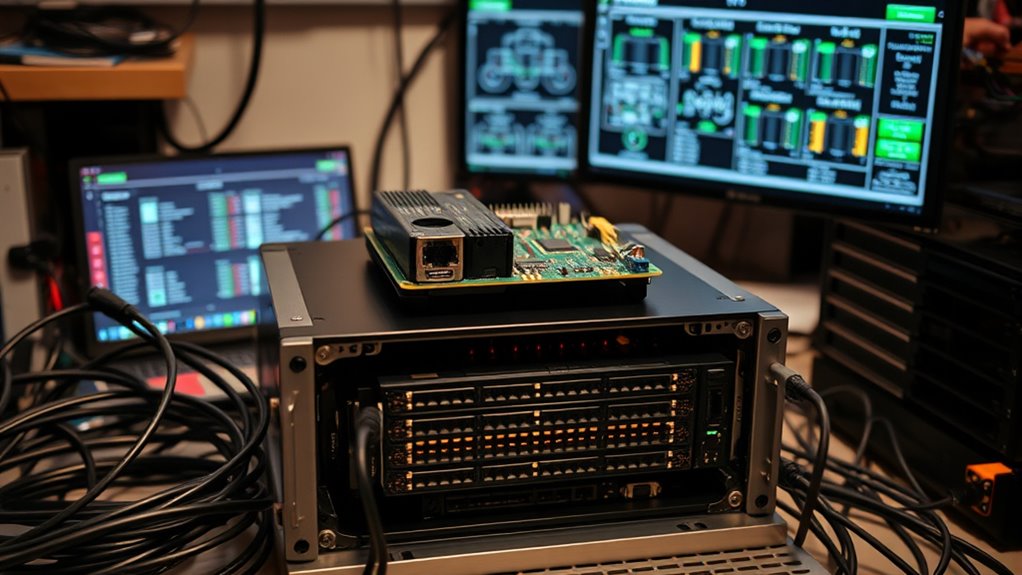
Before you start using your Plex server, it’s crucial to properly configure your network and storage settings to guarantee smooth streaming and reliable data management. First, assign a static IP address to your server to prevent IP changes that could disrupt access. Next, set up port forwarding on your router to allow remote connections. Make sure your storage drives are mounted correctly and have sufficient space for your media library. For maximum performance, enable network bonding if your hardware supports it, providing redundancy and increased bandwidth. Finally, organize your media folders systematically to streamline library management. Additionally, verifying your network stability can help prevent interruptions during streaming.
Setting Up Remote Access and User Permissions
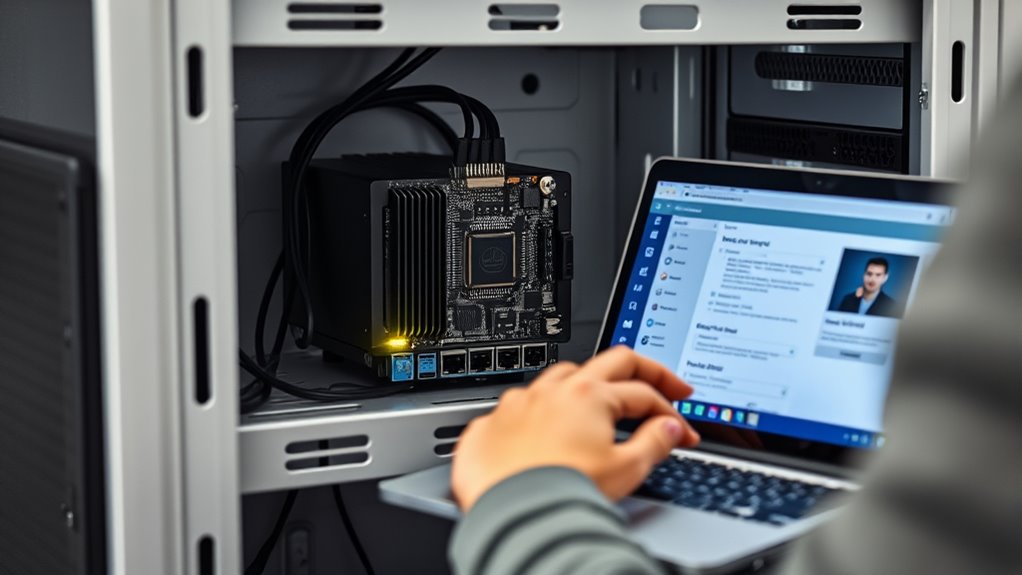
Setting up remote access and user permissions guarantees that you can enjoy your media library from anywhere while maintaining control over who can view or modify your content. To enable remote access, configure your router to forward the necessary ports for Plex, typically TCP 32400. Use a dynamic DNS service if you don’t have a static IP address, ensuring easy connection from outside your network. In Plex, navigate to the Settings menu, then Remote Access, and enable the feature. To manage user permissions, create individual accounts for family members or guests, setting appropriate access levels. You can restrict libraries or restrict certain features based on each user’s needs. Properly configuring remote access and permissions keeps your media secure while providing convenient access wherever you are. Additionally, understanding privacy and cookie policies can help you make informed decisions about your online security and data sharing.
Optimizing Performance and Troubleshooting Common Issues
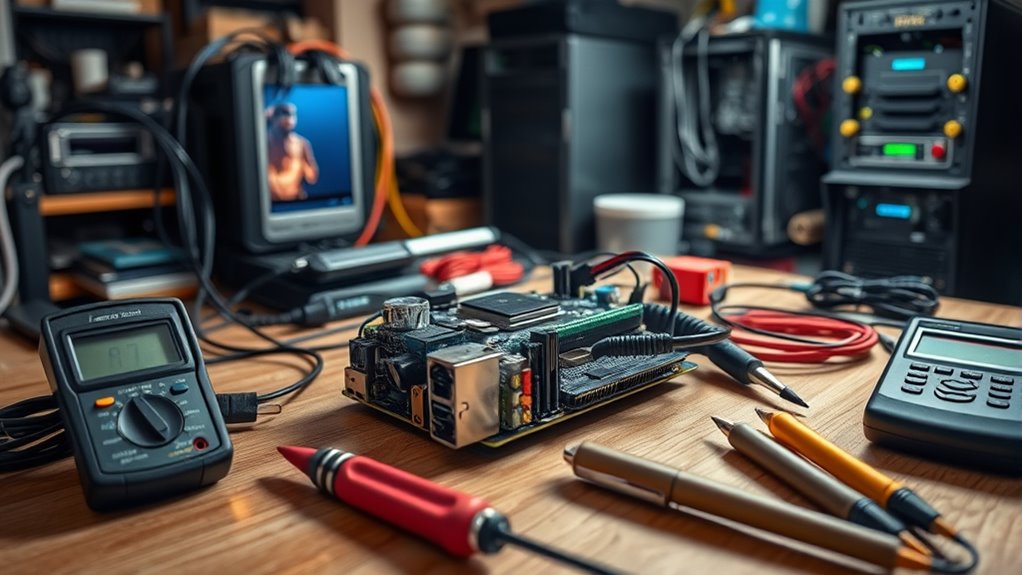
To get your Plex server running smoothly, you need to optimize hardware settings and manage network traffic effectively. You might encounter compatibility issues or performance bottlenecks that require troubleshooting. Let’s explore practical tips to tune your system and resolve common problems quickly.
Tuning Hardware Settings
Optimizing hardware settings is essential to guarantee your home Plex server runs smoothly and efficiently. Proper tuning can improve streaming quality, reduce lag, and prevent crashes. Start by adjusting CPU and GPU settings to prioritize performance over power saving, especially if you’re transcoding multiple streams. Make certain your device’s thermal management is effective to avoid overheating, which can throttle performance. Keep your storage devices optimized with proper filesystem settings and regular maintenance. Also, verify RAM allocations match your workload needs to prevent bottlenecks.
- Enable hardware acceleration for transcoding if supported
- Monitor system temperatures regularly
- Adjust CPU governor settings for performance
- Use SSDs for caching and active storage
- Keep firmware and software up to date
Managing Network Traffic
Ever wonder how network traffic impacts your Plex server’s performance? If your network is congested, streaming quality drops, buffering increases, and your server struggles to handle multiple streams. To optimize performance, prioritize your Plex traffic by setting Quality of Service (QoS) rules on your router. This ensures streaming packets get bandwidth preference. Monitor network usage with tools like Wireshark or your router’s analytics to identify bottlenecks or unnecessary data spikes. Use wired Ethernet connections whenever possible, as they provide more stability and lower latency than Wi-Fi. Additionally, segment your network with VLANs to isolate media traffic from other devices. Regularly update your router firmware and network drivers to fix bugs and improve efficiency. Managing network traffic effectively reduces issues and keeps your Plex server running smoothly.
Addressing Compatibility Issues
Compatibility issues can markedly affect your Plex server’s performance, especially when integrating hardware or software components. To ascertain smooth operation, check that all devices and software versions are compatible with your ARM hardware. You may encounter problems like playback errors or crashes if components aren’t supported. Troubleshoot by verifying firmware, drivers, and software updates. Consider using community forums to find solutions for specific hardware quirks.
- Confirm hardware compatibility before purchase
- Use official or well-supported software versions
- Test codecs and transcoding capabilities
- Keep firmware and drivers up-to-date
- Seek community advice for obscure issues
Addressing these compatibility issues early helps optimize performance and prevents frustrating disruptions during streaming.
Securing Your Plex Server for Privacy and Safety
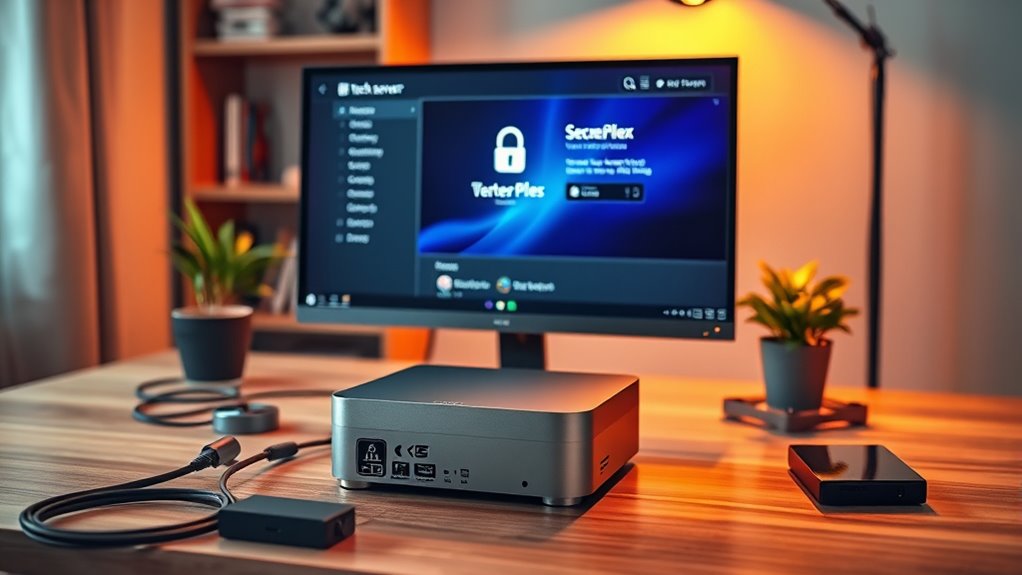
To keep your Plex server safe and private, you need to implement strong security measures from the start. First, enable a robust password for your server and avoid default credentials. Set up two-factor authentication if possible for added protection. Keep your system and Plex software updated regularly to patch vulnerabilities. Use a firewall to restrict access to trusted IPs and block unnecessary ports. Consider setting up a VPN for remote access, ensuring your streams stay encrypted. Regularly monitor server logs for suspicious activity. Additionally, limit user permissions so only trusted individuals can modify settings or access sensitive content. These steps help prevent unauthorized access, safeguarding your media library and personal data. Staying proactive is key to maintaining privacy and safety on your home media server.
Maintaining and Updating Your Media Server
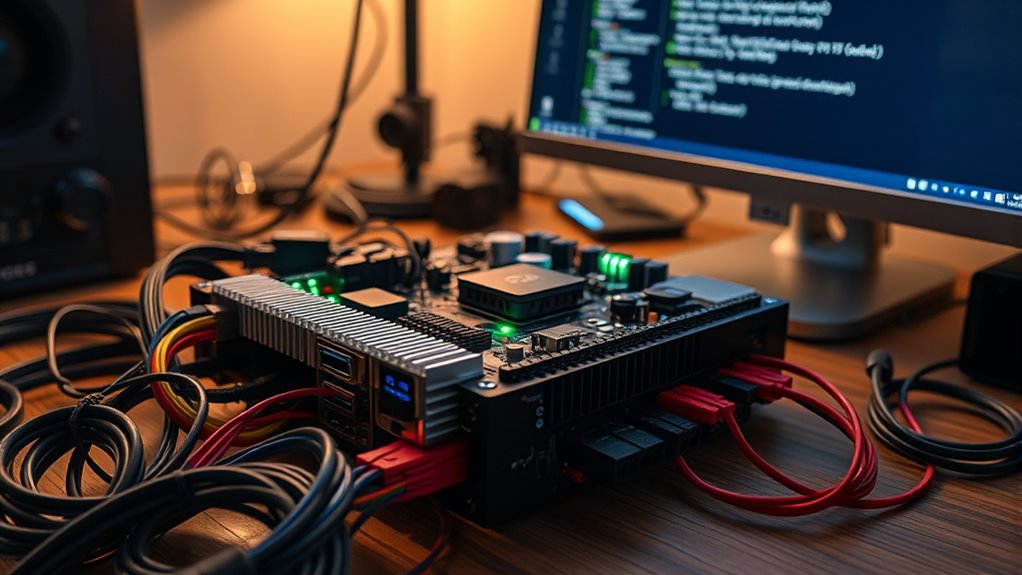
Regular maintenance and updates are essential to keep your media server running smoothly and securely. Staying on top of updates ensures you get the latest features, security patches, and bug fixes, reducing vulnerabilities. It also helps prevent performance issues and data loss. To keep everything in check, regularly verify your server’s health, back up your data, and monitor system logs. Automate updates when possible to save time and minimize errors. Remember, neglecting maintenance can lead to crashes or security breaches, compromising your media library.
Regular maintenance keeps your media server secure, stable, and running smoothly by preventing issues and protecting your library.
- Schedule regular system updates and patches
- Backup your configuration and media files periodically
- Monitor CPU, RAM, and storage usage
- Check logs for errors or unusual activity
- Remove unused plugins or add-ons
Expanding Your Setup With Additional Features
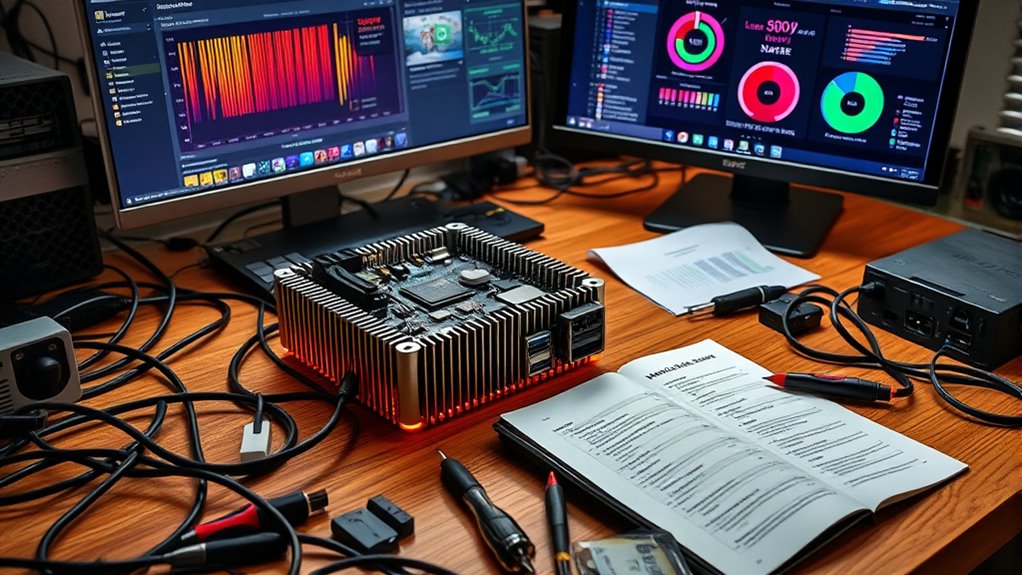
Expanding your Plex server setup with additional features can substantially enhance your media experience and functionality. You can add features like live TV, DVR, or even integrate with smart home devices. For example, setting up a TV tuner allows you to watch and record live broadcasts directly on your server. Using plugins or Docker containers, you can add tools like media downloading or automation scripts. Here’s a quick overview:
| Feature | Benefit | Setup Tips |
|---|---|---|
| Live TV & DVR | Record live broadcasts easily | Use a compatible tuner and guide |
| Mobile Sync | Access content on the go | Enable remote access on Plex |
| Automation | Automate library updates and tasks | Use scripts or plugins like Radarr |
Adding these features makes your media server more versatile and tailored to your needs.
Frequently Asked Questions
How Can I Backup My Plex Server Data Securely?
To back up your Plex server data securely, you should regularly copy your library files and configuration settings to a secure location, like an encrypted external drive or cloud storage. Use reliable backup software that encrypts data during transfer and storage. Automate backups to guarantee consistency, and verify backups periodically. This way, your server data stays protected, accessible, and recoverable in case of hardware failure or other issues.
What Are the Best Power Management Practices for Arm-Based Servers?
You should enhance power management by enabling sleep or hibernate modes during inactivity, which reduces energy use. Use power scheduling features to turn your server on and off automatically, avoiding unnecessary power consumption. Confirm your hardware supports efficient power states, and keep firmware updated for peak performance. Additionally, consider undervolting or using power-efficient components to extend hardware lifespan and reduce electricity costs.
How Do I Troubleshoot Streaming Quality Issues on ARM Devices?
Ever felt frustrated when your streaming stutters like a broken record? To troubleshoot streaming quality issues on ARM devices, start by checking your network connection—ensure it’s stable and fast. Then, monitor CPU and RAM usage to spot bottlenecks. Update your device’s firmware and Plex app regularly. Finally, lower the streaming quality settings if needed. These steps can transform your experience from frustration to smooth, seamless streaming.
Can I Run Multiple Media Servers on One ARM Hardware?
You can run multiple media servers on one ARM device, but it depends on its hardware capabilities. If your device has enough CPU power, RAM, and storage, you can install and operate several servers simultaneously. Keep in mind that running multiple servers might impact performance, so monitor your system resources regularly. Use lightweight server options and optimize settings to guarantee smooth streaming and avoid overloads.
What Are the Limitations of ARM Hardware for Transcoding Media?
Like a race car with a tiny engine, ARM hardware has limitations for transcoding media. You might find it struggles with high-resolution or multiple streams, as its CPUs often lack the processing power of traditional x86 servers. While it’s great for lightweight tasks, expect slower transcoding times and potential lag when handling demanding media files. So, if you plan heavy transcoding, consider more powerful hardware options.
Conclusion
Building a home Plex server on ARM hardware is like planting a seed that grows into a powerful media oasis. With the right device, setup, and security, you’ll enjoy seamless streaming and effortless management. Stay proactive with updates and expansions, and your media library will flourish. Remember, patience and attention turn a simple project into a rewarding sanctuary where your favorite content blooms at your fingertips. Happy streaming!

